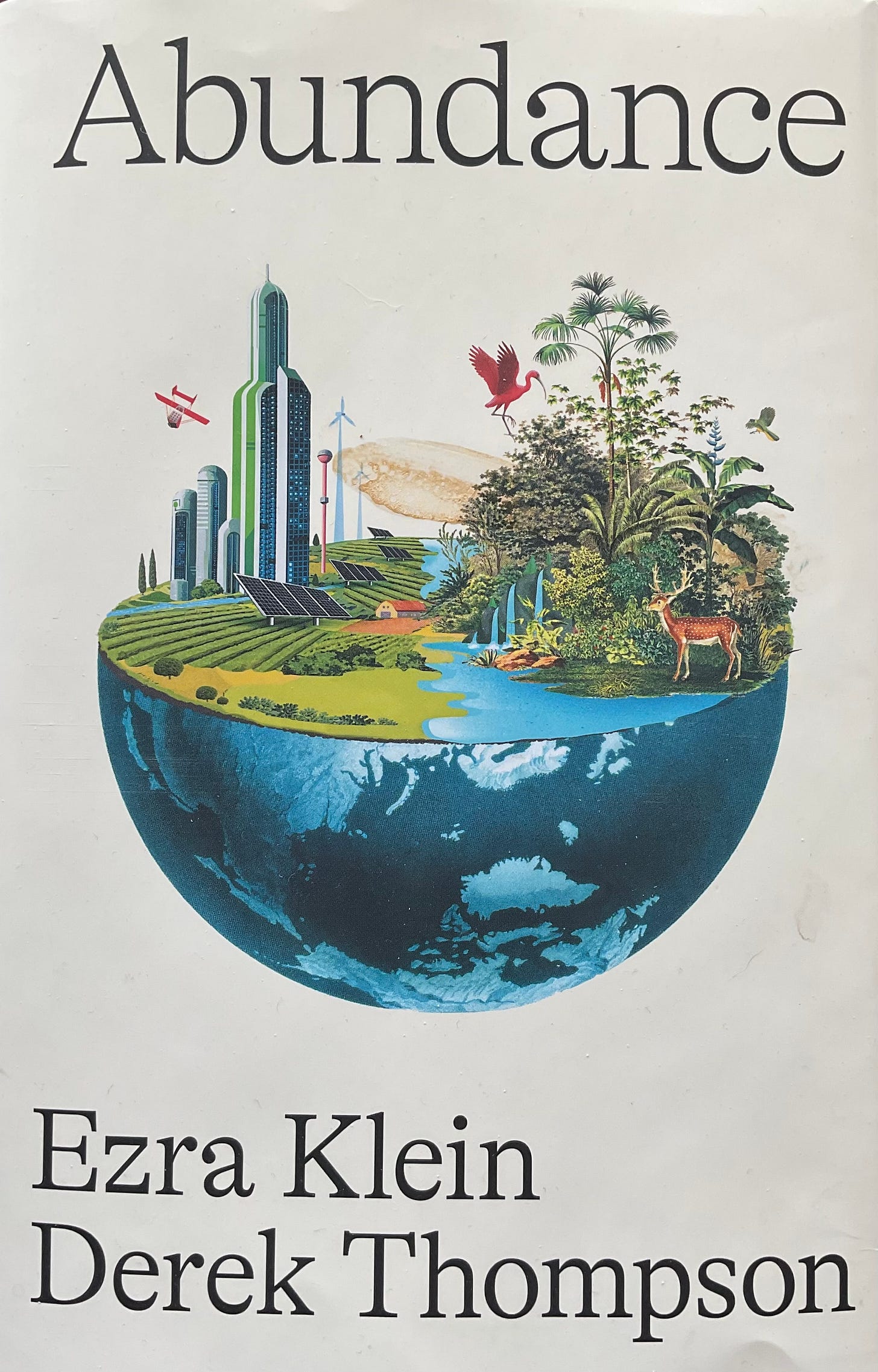I have paid attention to Ezra Klein for years, going back to his time creating the Wonkblog for the Washington Post. When he jumped to the New York Times, I would follow his stuff on social media. His podcast often proves to be interesting listening, as he is an excellent (if somewhat loquacious) interviewer. I enjoyed his first book, Why We’re Polarized, when it came out five years ago.
When I heard that he had released a new book, Abundance, coauthored with Derek Thompson, I wasn’t sure what to think. I’d read some mixed reviews. My daughter listened to the audiobook. When I got a gift certificate for guest speaking in my friend Tom’s class, I bought a copy and worked my way through it.
As I read Abundance, I remembered a book we’d covered in one of my undergraduate history classes decades ago. In 1888, Edward Bellamy wrote Looking Backward: 2000-1987. Here is the Wikipedia synopsis:
Bellamy's novel is set Boston, Massachusetts and tells the story of a young American man named Julian West who, in 1887, falls into a deep, hypnosis-induced sleep and wakes up 113 years later. He finds himself in the same location (Boston, Massachusetts), but in a totally changed world: It is the year 2000, and while he was sleeping, the United States has been transformed into a socialist utopia. The remainder of the book outlines Bellamy's thoughts about improving the future. The major themes include problems associated with capitalism, a proposed socialist solution of a nationalization of all industry, and the use of an "industrial army" to organize production and distribution, as well as how to ensure free cultural production under such conditions.
The central thesis for Klein and Thompson is that we have the capacity within our social context to solve key problems. We may see them as intractable, but that simply reflects a failure of imagination and political will.
This book is dedicated to a simple idea: to have the future we want, we need to build and invent more of what we need. That’s it. That’s the thesis.
It reads, even to us, as too simple. And yet, the story of America in the twenty-first century is the story of chosen scarcities. Recognizing that these scarcities are chosen — that we could choose otherwise — is thrilling. Confronting the reasons we choose otherwise is maddening. (4)
They argue that we have become caught between “a right that fought the government and a left that hobbled it”. The solution for us is to recognize the world we want and leverage ways to best pursue it. The table of contents lays out the steps they will address: Grow, Build, Govern, Invent, and Deploy.
There is something commendable in their vision. In fact, I’ve argued something similar on here — that we should identify some key social outcomes that maximize the common good and well being and backward-engineer the process to bring them about.
Grow: Why haven’t we solved our housing crisis? Part of the answer is NIMBY-ism. But a lot lies in zoning restrictions creating artificial scarcity. The labyrinthian permitting processes that slow construction play a role as do environmental requirements (and they describe a 1972 Supreme Court decision that allowed individuals to sue entities as a key part of the logjam).
Build: The central focus of this chapter is renewable energy. They cite concerns of the climate crisis as requiring “a liberalism that builds”. They extol the expansion of renewable energy and laud the Infrastructure and CHIPS acts of the Biden administration as key steps forward. But as other critics have pointed out (including people like Pete Buttigieg), the build-out has been too slow to fuel demand. Part of the delay comes from expectations of time consuming and often redundant demands for reports and paperwork as part of approvals. The failure of high-speed rail in California is a key illustration.
Govern: A key illustration in this chapter is the rapid re-opening of the I-95 bridge after its collapse in 2023. Governor Josh Shapiro declared a state of emergency and, with waivers from the Biden Administration, was able to get the bridge re-opened two weeks after the collapse. Earlier in the chapter, Klein and Thompson note that “[l]iberals speak as if they believe in government and then pass policy after policy hamstringing what it can actually do.” Shapiro’s emergency declaration allowed Pennsylvania to sideline those rules: avoiding time-consuming bidding contracts, working around environmental regulations, and taking chances with normal construction protocols.
Build: This requires having the federal government committed to building our scientific capacities. They speak of the role of DARPA, working in concert with university researchers to accomplish great technological advances.
Invent: These university researchers, however, are often limited by federal granting rules that reward them for taking small steps when big ones are needed. They advocate for funding competitions that would reward public and private entities for taking big swings at needed problems.
Deploy: The key insight here is the empower what they call “bottleneck detectives”. These are people who find the places where our progress gets bogged down and then work to remove those obstacles. The big example in this chapter is Operation Warp Speed that brought a Covid vaccine to millions of people.
In their concluding chapter, they write:
Abundance reorients politics around a fresh provocation: Can we solve our problems with supply? Many valuable questions bloom from this deceptively simply prompt. If there are not enough homes, can we make more? If not, why not? If there is not enough clean energy, can we make more? If not why not? If the government is repeatedly failing to complete major projects on time and on budget, then what is going wrong and how do we fix it? If the rate of scientific progress is slowing, how can we help scientists do their best work? If we need new technologies to solve our important problems, how do we pull these inventions from the future and distribute them to the present? (219)
That last line is what made me remember Edward Belamy and Looking Backward. But that’s also what left me ambivalent about the Klein/Howard argument. Abundance is at its best when it’s identifying the problems within our current local, state, and federal governments. Even if I accept their premise, what do we do?
They would have us, based on the Pennsylvania example, streamline the guardrails we have put in place to protect individuals from negative consequences of innovation. We don’t want unsafe construction or environmental degradation. We need to protect against corruption and cronyism. Even in our anti-DEI regime, we don’t want to reward contractors who openly discriminate against protected classes.
We could take bold steps if we were willing to plan and fund accordingly. If, for the sake of argument, we wanted to expand manufacturing in American society, we could create the equivalent of a moon-shot to organize government resources over time. That would require prioritizing that goal over others, but could certainly work better than relying on tariffs. And, of course, it would be better to build what the future requires rather than trying to recreate models from sixty years ago.
Then there is the problem of governing priorities. They make no mention of how the Loper-Bright decision that took away “chevron deference” has weakened the flexibility of federal agencies relative to the executive branch. We have an administration that has actively weakened the very institutions the authors celebrate as keys to innovation. We have the state of Texas looking for ways of dismantling all of the progress made on nonrenewable energy. And not only is RFK dismantling scientific agencies, no one in the administration seems willing to admit they were ever involved in Operation Warp Speed.
Finally, there is the problem of our political institutions. They have little incentive to work together to fix problems. Here’s an author reflecting on the limitations and opportunities in our polarized politics.
America’s political polarization has its roots in the civil rights era, in the Democratic Party choosing to embrace racial equality and the Republican Party providing a home to white backlash. Surely, the polarization that followed that progress was preferable to the oppression that preceded it. In a multiparty system, polarization is sometimes required for our political disagreements to express themselves. The alternative to polarization often isn’t consensus but suppression. We don’t argue over the problems we don’t discuss. But we don’t solve them either.
I agree with this analysis that Ezra Klein provided in Why We Are Polarized. And if we truly want to pursue the steps that are identified in Abundance, we need to pay a heck of a lot more attention to the political and economic incentives tilted toward keeping things in their current state (or worse).





Thanks for the review, John. I’ve read a couple of reviews in addition to yours, now, and as you note, though the analysis and recommendations are very good, <how> does any movement occur in the present polarized climate?
Thanks for this John.